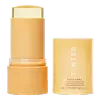Live Tinted HUEGUARD Invisible Sunscreen Stick SPF 50 Versus Live Tinted Hueguard Skin Tint SPF 50 Mineral Sunscreen Broad Spectrum
What's inside
What's inside
 Key Ingredients
Key Ingredients

 Benefits
Benefits

 Concerns
Concerns

 Ingredients Side-by-side
Ingredients Side-by-side

Homosalate 10%
Skin ConditioningOctocrylene 10%
UV AbsorberEthylhexyl Salicylate 5%
UV AbsorberButyl Methoxydibenzoylmethane 3%
UV AbsorberPolyamide-8
EmollientC12-15 Alkyl Benzoate
AntimicrobialCoco-Caprylate/Caprate
EmollientIsopropyl Isostearate
EmollientButyloctyl Salicylate
Skin ConditioningPolyamide-3
Vp/Eicosene Copolymer
Hylocereus Undatus Fruit Extract
Skin ConditioningRubus Chamaemorus Seed Oil
Skin ConditioningGlycine Soja Oil
EmollientCaprylyl Glycol
EmollientDiethylhexyl Syringylidenemalonate
Skin ProtectingTocopheryl Acetate
AntioxidantPentaerythrityl Tetra-Di-T-Butyl Hydroxyhydrocinnamate
AntioxidantPolyglyceryl-3 Diisostearate
EmulsifyingOryza Sativa Extract
AbsorbentOryza Sativa Germ Extract
EmollientCaprylic/Capric Triglyceride
MaskingHomosalate 10%, Octocrylene 10%, Ethylhexyl Salicylate 5%, Butyl Methoxydibenzoylmethane 3%, Polyamide-8, C12-15 Alkyl Benzoate, Coco-Caprylate/Caprate, Isopropyl Isostearate, Butyloctyl Salicylate, Polyamide-3, Vp/Eicosene Copolymer, Hylocereus Undatus Fruit Extract, Rubus Chamaemorus Seed Oil, Glycine Soja Oil, Caprylyl Glycol, Diethylhexyl Syringylidenemalonate, Tocopheryl Acetate, Pentaerythrityl Tetra-Di-T-Butyl Hydroxyhydrocinnamate, Polyglyceryl-3 Diisostearate, Oryza Sativa Extract, Oryza Sativa Germ Extract, Caprylic/Capric Triglyceride
Zinc Oxide 9.5%
Cosmetic ColorantAllantoin
Skin ConditioningAluminum Hydroxide
EmollientAscorbyl Palmitate
AntioxidantBisabolol
MaskingBuddleja Davidii Callus Extract
Butyloctyl Salicylate
Skin ConditioningC12-15 Alkyl Benzoate
AntimicrobialC13-15 Alkane
SolventCaprylic/Capric Triglyceride
MaskingCaprylyl Glycol
EmollientCitric Acid
BufferingCoco-Caprylate
EmollientCrocus Sativus Flower Extract
MaskingDisteardimonium Hectorite
StabilisingGlycerin
HumectantHippophae Rhamnoides Seed Oil
Skin ProtectingHydrogenated Lecithin
EmulsifyingHydrolyzed Sodium Hyaluronate
Skin ConditioningIron Oxides
Isoamyl Laurate
EmollientLecithin
EmollientMethylpropanediol
SolventPhenylpropanol
MaskingPhysalis Pubescens Fruit Juice
Skin ConditioningPolyglyceryl-3 Polyricinoleate
EmulsifyingPolyglyceryl-4 Diisostearate/Polyhydroxystearate/Sebacate
EmulsifyingPyrus Malus Fruit Extract
Skin ConditioningSilica
AbrasiveSilica Silylate
EmollientSodium Chloride
MaskingSodium Hyaluronate
HumectantCI 77891
Cosmetic ColorantTocopherol
AntioxidantWater
Skin ConditioningWithania Somnifera Root Extract
Skin ConditioningXanthan Gum
EmulsifyingZinc Oxide 9.5%, Allantoin, Aluminum Hydroxide, Ascorbyl Palmitate, Bisabolol, Buddleja Davidii Callus Extract, Butyloctyl Salicylate, C12-15 Alkyl Benzoate, C13-15 Alkane, Caprylic/Capric Triglyceride, Caprylyl Glycol, Citric Acid, Coco-Caprylate, Crocus Sativus Flower Extract, Disteardimonium Hectorite, Glycerin, Hippophae Rhamnoides Seed Oil, Hydrogenated Lecithin, Hydrolyzed Sodium Hyaluronate, Iron Oxides, Isoamyl Laurate, Lecithin, Methylpropanediol, Phenylpropanol, Physalis Pubescens Fruit Juice, Polyglyceryl-3 Polyricinoleate, Polyglyceryl-4 Diisostearate/Polyhydroxystearate/Sebacate, Pyrus Malus Fruit Extract, Silica, Silica Silylate, Sodium Chloride, Sodium Hyaluronate, CI 77891, Tocopherol, Water, Withania Somnifera Root Extract, Xanthan Gum
Ingredients Explained
These ingredients are found in both products.
Ingredients higher up in an ingredient list are typically present in a larger amount.
Butyloctyl Salicylate is a chemical UV filter structurally similar to octisalate. It is a photostabilizer, SPF booster, emollient and solvent. This ingredient helps evenly spread out ingredients.
According to a manufacturer, it is suitable for pairing with micro Titanium Dioxide, Zinc Oxide, and pigments.
Photostabilizers help stabilize UV-filters and prevents them from degrading quickly.
Learn more about Butyloctyl SalicylateC12-15 Alkyl Benzoate is made up of Benzoic Acid and long chain alcohols. It has a low molecular weight.
C12-15 Alkyl Benzoate is an emollient and texture enhancer. Due to its solubility, it is often used in sunscreens to help evenly distribute active ingredients.
As an emollient, C12-15 Alkyl Benzoate helps soften and hydrate your skin. Emollients create a film on your skin that traps moisture within.
This ingredient has been reported to cause eye irritation.
Learn more about C12-15 Alkyl BenzoateThis ingredient is an emollient, solvent, and texture enhancer. It is considered a skin-softener by helping the skin prevent moisture loss.
It helps thicken a product's formula and makes it easier to spread by dissolving clumping compounds.
Caprylic Triglyceride is made by combining glycerin with coconut oil, forming a clear liquid.
While there is an assumption Caprylic Triglyceride can clog pores due to it being derived from coconut oil, there is no research supporting this.
Learn more about Caprylic/Capric TriglycerideCaprylyl Glycol is a humectant and emollient, meaning it attracts and preserves moisture.
It is a common ingredient in many products, especially those designed to hydrate skin. The primary benefits are retaining moisture, skin softening, and promoting a healthy skin barrier.
Though Caprylyl Glycol is an alcohol derived from fatty acids, it is not the kind that can dry out skin.
This ingredient is also used as a preservative to extend the life of products. It has slight antimicrobial properties.
Learn more about Caprylyl Glycol